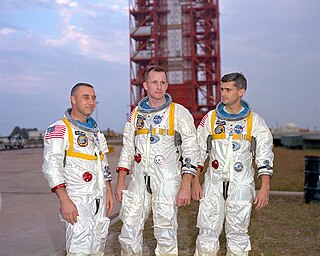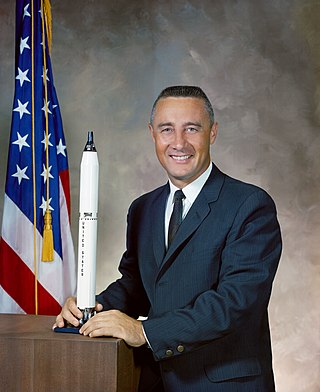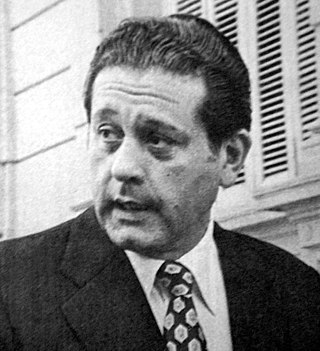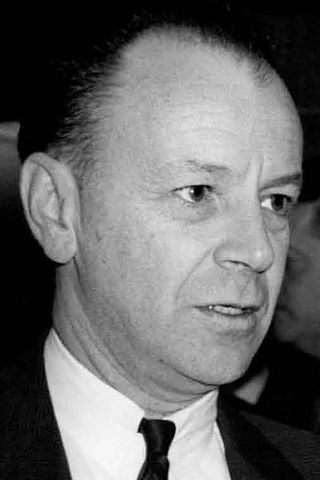Related Research Articles

Apollo 1, initially designated AS-204, was intended to be the first crewed mission of the Apollo program, the American undertaking to land the first man on the Moon. It was planned to launch on February 21, 1967, as the first low Earth orbital test of the Apollo command and service module. The mission never flew; a cabin fire during a launch rehearsal test at Cape Kennedy Air Force Station Launch Complex 34 on January 27 killed all three crew members—Command Pilot Gus Grissom, Senior Pilot Ed White, and Pilot Roger B. Chaffee—and destroyed the command module (CM). The name Apollo 1, chosen by the crew, was made official by NASA in their honor after the fire.

Virgil Ivan "Gus" Grissom was an American engineer, pilot in the United States Air Force, and member of the Mercury Seven selected by National Aeronautics and Space Administration's (NASA) as Project Mercury astronauts to be the first Americans in outer space. He was a Project Gemini and an Apollo program astronaut. As a member of the NASA Astronaut Corps, Grissom was the second American to fly in space in 1961. He was also the second American to fly in space twice, preceded only by Joe Walker with his sub-orbital X-15 flights.

Edward Higgins White II was an American aeronautical engineer, United States Air Force officer, test pilot, and NASA astronaut. He was a member of the crews of Gemini 4 and Apollo 1.

Roger Bruce Chaffee was an American naval officer, aviator and aeronautical engineer who was a NASA astronaut in the Apollo program.

René Gerónimo Favaloro was an Argentine cardiac surgeon and educator best known for his pioneering work on coronary artery bypass surgery using the great saphenous vein.

Donn Fulton Eisele was a United States Air Force officer, test pilot, and later a NASA astronaut. He occupied the command module pilot seat during the flight of Apollo 7 in 1968. After retiring from both NASA and the Air Force in 1972, he became the Peace Corps country director for Thailand, before moving into private business.

Project Gemini was NASA's second human spaceflight program. Conducted between projects Mercury and Apollo, Gemini started in 1961 and concluded in 1966. The Gemini spacecraft carried a two-astronaut crew. Ten Gemini crews and 16 individual astronauts flew low Earth orbit (LEO) missions during 1965 and 1966.
The Apollo 1 Hills are three hills on Mars named to memorialize the crew of Apollo 1. The three hills were some of the first landmarks sighted following the January 7, 2004, landing of the Spirit rover on Mars.

The Space Mirror Memorial, which forms part of the larger Astronauts Memorial, is a National Memorial on the grounds of the John F. Kennedy Space Center Visitor Complex on Merritt Island, Florida. It is maintained by the Astronauts Memorial Foundation (AMF), whose offices are located in the NASA Center for Space Education next door to the Visitor Complex. The memorial was designed in 1987 by Holt Hinshaw Pfau Jones, and dedicated on May 9, 1991, to remember the lives of the men and women who have died in the various space programs of the United States, particularly those of NASA. The Astronauts Memorial has been designated by the U.S. Congress "as the national memorial to astronauts who die in the line of duty".
Several planned missions of the Apollo crewed Moon landing program of the 1960s and 1970s were canceled, for reasons which included changes in technical direction, the Apollo 1 fire, hardware delays, and budget limitations. After the landing by Apollo 12, Apollo 20, which would have been the final crewed mission to the Moon, was canceled to allow Skylab to launch as a "dry workshop". The next two missions, Apollos 18 and 19, were later canceled after the Apollo 13 incident and further budget cuts. Two Skylab missions also ended up being canceled. Two complete Saturn V rockets remained unused and were put on display in the United States.
The intra-aortic balloon pump (IABP) is a mechanical device that increases myocardial oxygen perfusion and indirectly increases cardiac output through afterload reduction. It consists of a cylindrical polyurethane balloon that sits in the aorta, approximately 2 centimeters (0.79 in) from the left subclavian artery. The balloon inflates and deflates via counter pulsation, meaning it actively deflates in systole and inflates in diastole. Systolic deflation decreases afterload through a vacuum effect and indirectly increases forward flow from the heart. Diastolic inflation increases blood flow to the coronary arteries via retrograde flow. These actions combine to decrease myocardial oxygen demand and increase myocardial oxygen supply.

Harrison Allen Storms, Jr., nicknamed "Stormy", was an American aeronautical engineer employed by North American Aviation, best known for his role in managing the design and construction of the Apollo Command/Service Module. North American came under severe criticism in 1965–66 by NASA's Apollo program director for cost overruns, delivery delays, and poor quality, and Storms was reassigned to the LA Division in 1967 from the aftermath of the Apollo 1 fire which killed three astronauts.

The United States Astronaut Hall of Fame, located inside the Kennedy Space Center Visitor Complex Heroes & Legends building on Merritt Island, Florida, honors American astronauts and features the world's largest collection of their personal memorabilia, focusing on those astronauts who have been inducted into the Hall. Exhibits include Wally Schirra's Sigma 7 space capsule from the fifth manned Mercury mission and the Gemini IX spacecraft flown by Gene Cernan and Thomas P. Stafford in 1966.
Adrian Kantrowitz was an American cardiac surgeon whose team performed the world's second heart transplant attempt at Maimonides Medical Center in Brooklyn, New York on December 6, 1967. The infant lived for only six hours. At a press conference afterwards, Kantrowitz emphasized that he considered the operation to have been a failure.
Betty Lavonne Grissom was the plaintiff in a successful lawsuit against a NASA contractor which established a precedent for families of astronauts killed in service to receive compensation. Her husband Gus Grissom, one of the Mercury Seven astronauts, died in the first fatal accident in the history of the United States space program. Ms. Grissom has been portrayed in the books The Right Stuff (1979) by Tom Wolfe and The Astronaut Wives Club (2013) by Lily Koppel and by the actors Veronica Cartwright and JoAnna Garcia in the film and television adaptations of those books.
The 1967 Rose Bowl was the 53rd edition of the college football bowl game, played at the Rose Bowl in Pasadena, California, on Monday, January 2. The game matched the #7 Purdue Boilermakers of the Big Ten Conference and the unranked USC Trojans of the AAWU (Pac-8). Purdue won 14−13, after USC scored a touchdown in the fourth quarter and opted to go for a two-point conversion to win the game, rather than kicking an extra point to tie.

The THUMS Islands are a set of four artificial islands in San Pedro Bay off the coast of Long Beach, California. The THUMS Islands were built in 1965 to tap into the East Wilmington Oil Field. The landscaping and sound walls were designed to camouflage the operation and reduce noise, and they are the only decorated oil islands in the United States. The islands were named for the company who bid for original operating contract, THUMS, a consortium named after its parent companies: Texaco, Humble, Unocal, Mobil, and Shell.
Astronauts Day is an American holiday, dedicated to NASA astronauts and their achievements. It is a "floating" holiday, observed on the last Friday of January.
References
- ↑ "1967: The Naked Ape steps out". On This Day. BBC News. 1967-10-12. Retrieved 2011-08-24.
- ↑ Hewish, A.; Bell, S. J.; Pilkington, J. D. H.; Scott, P. F.; Collins, R. A. (24 February 1968). "Observation of a Rapidly Pulsating Radio Source". Nature . 217 (5130): 709–713. Bibcode:1968Natur.217..709H. doi:10.1038/217709a0. S2CID 4277613.
- ↑ Crilly, Tony (2007). 50 Mathematical Ideas you really need to know. London: Quercus. p. 69. ISBN 978-1-84724-008-8.
- ↑ Acheson, David (2002). 1089 and All That. Oxford University Press. p. 106. ISBN 0-19-851623-1.
- ↑ Langlands, Robert (1967), Letter to Prof. Weil.
- ↑ Weinberg, S. (1967). "A Model of Leptons" (PDF). Physical Review Letters . 19 (21): 1264–1266. Bibcode:1967PhRvL..19.1264W. doi:10.1103/PhysRevLett.19.1264. Archived from the original (PDF) on 2012-01-12. Retrieved 2014-02-18.
- ↑ Toda, Morikazu (1967). "Vibration of a chain with a non-linear interaction". Journal of the Physical Society of Japan . 22 (2): 431–436. Bibcode:1967JPSJ...22..431T. doi:10.1143/JPSJ.22.431.
- ↑ Favaloro, René G.; et al. (November 1971). "Acute coronary insufficiency (impending myocardial infarction and myocardial infarction): surgical treatment by the saphenous vein graft technique". American Journal of Cardiology . 28 (5): 598–607. doi:10.1016/0002-9149(71)90104-4. PMID 5116978. S2CID 2643284.
- ↑ Siegert, R.; et al. (2009). "Zur Ätiologie einer unbekannten, von Affen ausgegangenen menschlichen Infektionskrankheit". Deutsche Medizinische Wochenschrift. 92 (51): 2341–3. doi:10.1055/s-0028-1106144. PMID 4294540.
- ↑ Nussenzweig, Ruth; Vanderberg, J.; Most, H.; Orton, C. (1967-10-14). "Protective Immunity produced by the Injection of X-irradiated Sporozoites of Plasmodium berghei". Nature. 216 (5111): 160–162. Bibcode:1967Natur.216..160N. doi:10.1038/216160a0. PMID 6057225. S2CID 4283134 . Retrieved 2016-03-03.
- ↑ Lyons, Richard D. (7 December 1967). "Heart Transplant Fails to Save 2-Week-old Baby in Brooklyn". The New York Times . Retrieved 2008-11-19.
- ↑ "The Ultimate Operation". Time . 15 December 1967. Archived from the original on December 15, 2008. Retrieved 2008-11-19.
- ↑ Hoffman, Jascha (19 November 2008). "Dr. Adrian Kantrowitz, Cardiac Pioneer, Dies at 90". The New York Times . Retrieved 2008-11-19.
- ↑ In their Talairach Atlas. Toga, Arthur W. (1998). Brain Warping. Academic Press. p. 264. ISBN 978-0-08-052554-9.
- ↑ Baines, Mary. "History". St Christopher's. Retrieved 2012-08-08.
- ↑ Penguin Pocket On This Day. Penguin Reference Library. 2006. ISBN 978-0-14-102715-9.
- ↑ "Roger B. Chaffee | American astronaut". Encyclopedia Britannica. Retrieved 19 January 2021.
- ↑ "Virgil I. Grissom | American astronaut". Encyclopedia Britannica. Retrieved 19 January 2021.
- ↑ "Edward H. White II | American astronaut". Encyclopedia Britannica. Retrieved 19 January 2021.